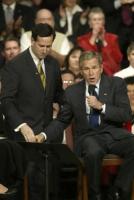November 7, 2006 was a terrible, horrible, no good, very bad day for a lot of Republicans. It’s the day the Democrats won the majority in the US Senate and House. Über-conservative Republican Senator Rick Santorum was one of the Republicans who lost his seat that day; it was the “largest margin of defeat for an incumbent Senator since… 1980.” Ouch .
Determined not to be relegated to the “where are they now?” column, Santorum has been keeping his conservative fan club happy with his semi-regular opinion pieces in the Philadelphia Inquirer. He pontificates on his favorite subjects, like “family values ” and “evildoers “.
However, today Santorum digresses, and puts on his “clean coal” salesman hat.
Santorum’s column is a train wreck, full of inept comparisons and non sequiturs. Writing and composition instructors, as well as logic and rhetoric teachers, beware. Rick Santorum will make your blood pressure go up.
‘Coal’ is not a dirty word if we are realistic about saving the Earth
How is a poll from a year ago “recent”? Not only that, but Santorum apparently missed the part of the poll that said 56% of the people polled thought temperatures around the world have risen. The poll result negates what he says next:
But then he contradicts himself and says “the hype” is working, and that he’s kinda buying into it. Aw shucks:
He continues with how the hype really isn’t working. Oh, and yawn, here comes the predictable Inhofian Science:
Could it be that Americans know that over time the Earth goes through natural cooling and heating cycles?
Could it be that they recognize that most of the doomsday scenarios are not scientifically supported and that even the “consensus” projections are just that – projections based upon highly interactive questionable assumptions over long periods of time?
FAIL (as the kids on the internet say ). Wrong. Someone’s been looking at cooked graphs .
Finally, after sixteen paragraphs of tired rhetoric, he gets to his point:
There is that dirty word: coal.
Those lumps of carbon turn the lights on in 50 percent of American homes.
In an age when energy independence is not only important for our economy, but also vital to our national security, we can’t afford not to use this plentiful domestic resource.
Yes, indeed. Rick has joined the fantasy world of the “clean coal” promoters. He doesn’t make his point very well, because he suddenly muddles his point by bashing Barack Obama:
CCS separates and captures carbon dioxide at the power plant before it is emitted. It is then liquefied, transported by pipeline and injected deep underground into geological formations for permanent storage.
Contrast this down-to-earth, commonsense approach with Barack Obama’s other-worldly proposal. He’s calling for a mandatory 80 percent cut in carbon emissions by 2050.
Let’s recap what Rick’s trying to say:
- Global warming is not real.
- The media makes people think it is, or maybe not (?), but at least Rick recycles.
- Coal is clean. CCS works. Seriously, for reals!
- Barack Obama is lame and unrealistic, because he doesn’t believe in “clean coal” as an energy source.
FAIL, Rick. Here’s reality:
Global warming is real. A 2008 poll shows that nearly half of Americans believe humans cause global warming, although this percentage is down from a previous poll.
Coal is not “clean”. And Barack Obama actually promotes “clean coal”, so Rick’s just plain lying.
I’d like to suggest some reading material for Rick, although I think he’s beyond hope.
But we have faith in the the reality-based community (both online and off).
We’re counting on you to see through the “clean coal” spin . It’s your future – and the Earth’s – that’s at stake.
Subscribe to our newsletter
Stay up to date with DeSmog news and alerts






